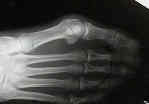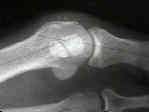- anatomy:
- there is no direct connection between sesamoids & flexor hallucis longus tendon that runs between them;
- tibial and fibular sesamoids are located within tendons of FHB and forms portion of the plantar plate;
- abductor hallucis & adductor hallucis tendons have fibrous insertions into the tibial and fibular sesamoids respectively;
- deep transverse metatarsal ligament attaches to the fibular sesamoid;
- tibial sesamoid normally assumes most of the wt bearing fx transmitted to the head of the first metatarsal;
- function:
- sesamoids increase mechanical advantage of FHB, assist w/ bearing under great metatarsal, and elevate the metatarsal head off of ground;
- consequences of excision
- stiffness, claw toe, and hallux valgus
- Radiographs:
- standing AP and standing lateral radiograph (lateral radiograph helps evaluate possible cavus deformity);
- a sesamoid view is essential;
- need to consider bipartite, sesamoid, osteochondritis dissecans of sesamoid, or fracture of the sesmoid;
- sesamoid view:
- the only radiographic view that reliably shows sesamoid subluxation is the wt bearing sesamoid view;
- note that AP views of the foot should not be used to assess sesamoid subluxation since 1st metatarsal pronation or subluxation
may accentuate or diminish the true sesamoid position;
- bipartite sesamoid: (versus sesamoid frx)
- only 25 % of population will have bipartitie sesamoid, but of these, 85% are bilateral;
- the tibial sesamoid will more often be bipartite that the lateral sesamoid;
- bipartite sesamoid has narrow & distinct regular edges;
- bipartite sesamoids also are usually larger than single sesamoid;
- bipartite sesamoids have smooth margins whereas frx demonstrate irregular frx lines;
- bone scan is also helpful;
- Patho-Anatomy:
- turf toe
- sesamoid fractures
- hallux valgus
- because the sesamoids are eembedded in teh tendon of the FHB, which inserts into the base of the proximal phalanx, any degree of hallux valgus tends to rotate both sesamoids on the long axis;
- fibular sesamoid tends to rotate into the 1st metatarsal interspace, thereby disposing of the possibility of its becoming a wt bearing focus;
- tibial sesmoid rotate on its side & thus become wt bearing pivot;
- sesamoiditis
Injuries to the hallucal sesamoids in the athlete.
Anatomic variations in the first ray: Part II. Disorders of the sesamoids.
Sesamoid disorders and treatment. An update.
Congenital absence of the hallux fibular sesamoid: a case report and review of the literature.
Assessing sesamoid subluxation: how good is the AP radiograph?
Return to activity after sesamoidectomy in athletically active individuals.
Acute Fibular Sesamoid Fracture: One Part of the Spectrum of Sesamoid Pathologies





